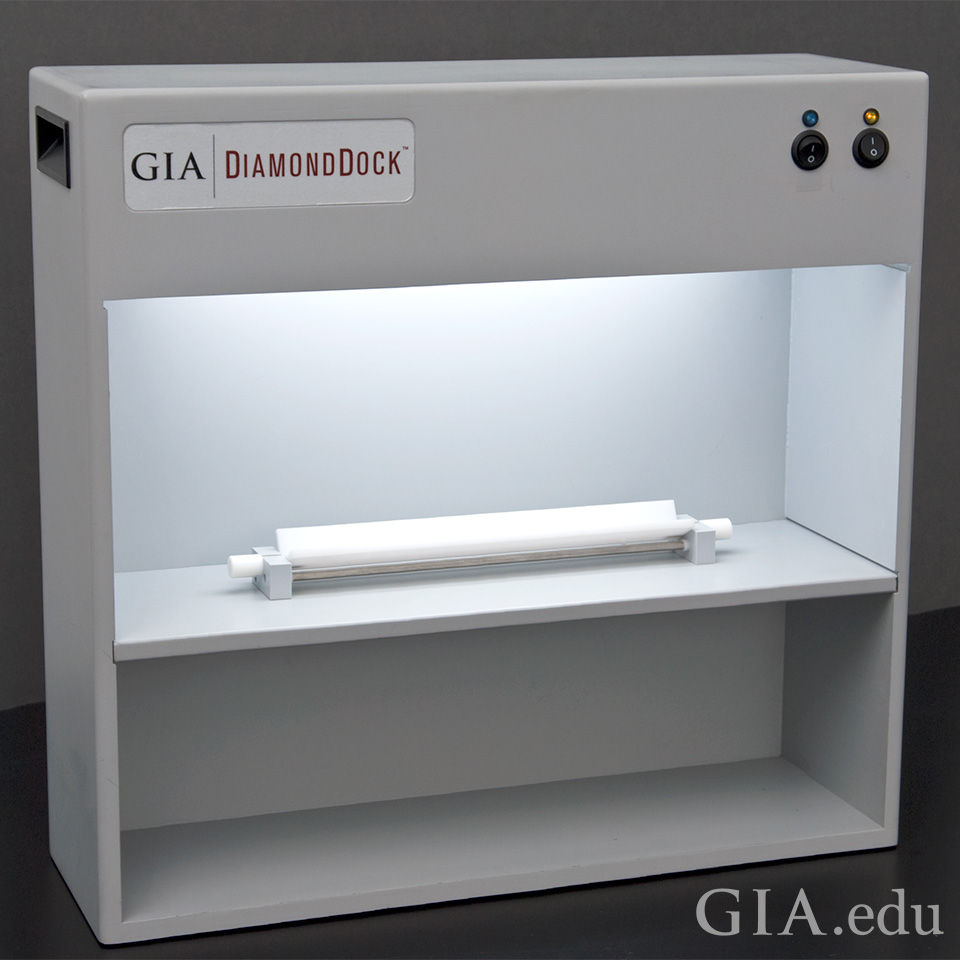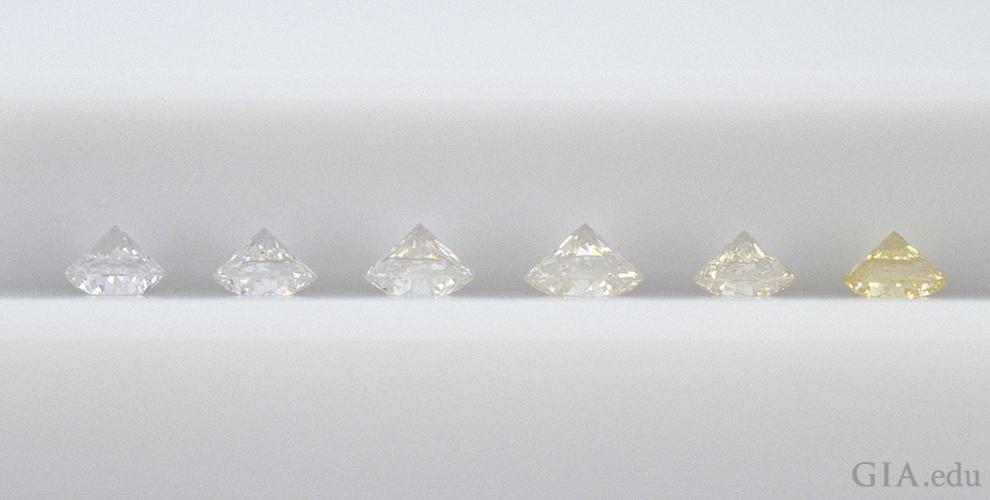If you’re shopping for diamonds and have done your 4Cs homework (color, clarity, cut, carat weight), then you already know that diamond color has a lot to do with overall diamond quality. The range of diamond color can be so subtle that your untrained eye may not be able to tell the difference between a nearly colorless diamond and a colorless one. But you’ll have no trouble in seeing the difference in diamond price. So how do you know exactly what you’re buying? That’s where an independent diamond grading report like GIA’s comes in. It provides a definitive, unbiased assessment of your diamond’s 4Cs, including its diamond color grade.
In prior posts, we dug deeper into the information contained in GIA Diamond Grading Reports, to explain the plotting diagram and its relation to diamond clarity, and how you can learn more about your diamond’s cut grade by understanding its measurements, as well as the polish and symmetry grades listed in your report. In this post, we’ll focus on the color-related information contained in GIA reports. Read on to learn more about GIA reports, GIA’s methods for determining a diamond color grade, and how to use this information to help you make informed buying decisions.
The GIA Diamond Color Chart or Scale
GIA Diamond Grading Reports and GIA Diamond Dossiers® depict a chart called the GIA Diamond Color Scale, showing the 23 grades for diamonds that fall within the D-to-Z color range. This is a reference tool for you to use to see how your diamond’s color grade falls within the scale. The scale begins with D (colorless) and progresses through the alphabet to Z (for diamonds that are light yellow, light brown, or light gray). Each letter represents a narrow range of color, not a specific point. So two diamonds with the same color grade can actually differ slightly in their depth of color, but the difference within a letter grade is so subtle that it’s only noticeable to a trained diamond grader.
On the GIA Diamond Color Scale, the letter grades are grouped into categories:
- Colorless (D-F): The most chemically pure diamonds of the D-to-Z range
- Near-colorless (G-J): Color is often unnoticeable except by trained graders
- Faint (K-M): Color is still difficult to see by the untrained eye
- Very Light (N-R): Color can be seen in larger stones by an untrained eye
- Light (S-Z): Color can be seen in many sized stones. Diamonds appear distinctly yellow or brown but not so colored to be considered a “fancy” colored diamond.

A GIA Diamond Grading Report provides a complete assessment of the 4Cs, including a diamond’s color grade. The report also contains the official GIA Diamond Color Scale as a reference tool.
The GIA Diamond Color Grade
The left panel of the GIA Diamond Grading Report or GIA Diamond Dossier® contains the grading results of your diamond, including its color grade. The grade was determined by following a strict protocol to ensure the utmost accuracy and consistency.

The GIA DiamondDock viewing box provides controlled surroundings for making visual comparisons of diamonds. The raised platform is set at the precise height for accurate color grading and holds a viewing tray for master diamonds. Photo: Robert Weldon/GIA
Light source and background can have a significant impact on a diamond’s appearance, so GIA grades color in a highly standardized and controlled viewing environment. Diamonds are examined under a daylight-fluorescent light source, against a neutral gray background. They are held in a white non-reflective grading tray, with subdued, low-level ambient lighting in the surrounding area. Even the grader’s sightline and viewing angle are tightly controlled to prevent a diamond’s brightness and scintillation from interfering with an accurate color assessment.
GIA determines a diamond color grade by comparing the diamond to a set of masterstones. These are diamonds that have been carefully selected to meet specific criteria for carat weight, color, clarity and cut. Each masterstone in the set represents a letter grade. The masterstones are positioned in left to right order in the grading tray, with their tables facing down. The grader then proceeds to systematically compare the diamond being graded to each masterstone, until she determines a color match. She submits her grading opinion into GIA’s database and the diamond’s final color grade is determined when there are sufficient agreeing opinions.
Diamond Color Treatments
Sometimes diamonds may be treated to improve their color appearance, and GIA tests all diamonds for treatments as part of its grading process. If the diamond’s color is a result of a treatment that is considered to be permanent, the GIA diamond grading report will denote a detected treatment by placing an asterisk after the color grade and will list the treatment process in the “Comments” section of the report. If the diamond’s color is a result of an unstable or reversible treatment, a GIA Identification Report will be issued instead.
An example of a permanent diamond color treatment is High Pressure, High Temperature (HPHT), a process that can turn some brownish diamonds colorless or transform these brownish stones into other colors like yellow, greenish yellow or green. An example of an unstable diamond color treatment is coating.
Diamond Fluorescence
GIA diamond grading reports will include a description of a diamond’s fluorescence, listed as None, Faint, Medium, Strong, or Very Strong. Fluorescence refers to the strength or intensity of the diamond’s reaction to long-wave UV, which is an essential component of daylight. Fluorescence is common in diamonds, and is considered an identifying characteristic. In natural diamonds, blue is the most common color of fluorescence, but other colors are possible.

Blue is by far the most common fluorescence color in gem diamonds. These diamonds exhibit varying strengths of fluorescence when exposed to the concentrated long-wave ultraviolet radiation of a UV lamp. Photo: Harold & Erica Van Pelt/GIA. Courtesy: Harry Winston, Inc.
Fluorescence will not affect the color grade but the strength of fluorescence can alter the appearance of a diamond’s color when viewed under conditions that differ from those in the laboratory. For example, in bright sunshine some diamonds with a stronger blue fluorescence may appear more colorless; and diamonds with Very Strong fluorescence may appear to have a hazy or oily appearance.
We hope this post has given you deeper insight into the diamond color information in GIA diamond grading reports, as well as the methodology GIA uses in arriving at a diamond color grade. By knowing the 4Cs and how to read a diamond grading report, you’ll be able to better understand the qualities of the diamonds you’re seeing as you consider your purchase. This knowledge will help you narrow your choices and make an informed buying decision, so that the diamond you select is truly the diamond of your dreams.
Learn even more about the GIA diamond color chart – the official GIA Diamond Color Scale – and experience the subtle differences in color for D-to-Z diamonds, with an interactive diamond color tool.
Custom Field: Array

